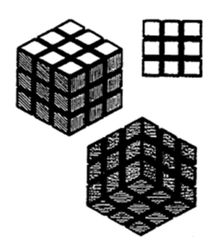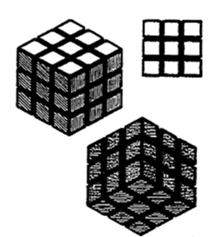
1. Hechos.
La sociedad británica Seven Towns Ltd obtuvo en 1999 el registro de la marca de la Unión Europea tridimensional no. 162784 consistente en la forma del cubo de Rubik para distinguir en clase 28 “Puzzles tridimensionales”:

Marca de la UE nº 162784 objeto de la controversia
En 2006, el productor de juguetes Simba Toys GmbH & Co. KG presentó una solicitud de nulidad de esta marca. La EUIPO desestimó su solicitud, por lo que Simba Toys interpuso un recurso ante el Tribunal General.
El Recurso se basaba fundamentalmente en el argumento de que la marca incorpora un resultado técnico consistente en la capacidad de rotación del propio producto, incurriendo por tanto en una de las prohibiciones absolutas de registro.
El Tribunal General, confirmando la decisión de la EUIPO de mantener el registro, consideró lo siguiente (asunto T-450/09):
- Las líneas negras no aluden en absoluto a la capacidad de rotación de los elementos individuales del cubo, de modo que no cumplen ninguna función técnica.
- La capacidad de rotación del cubo (el resultado técnico) se debe a un mecanismo interno del cubo que no puede verse en sus representaciones gráficas.
- El registro de esta marca no permite que su titular prohíba comercializar a terceros todo tipo de puzles tridimensionales con capacidad de rotación, sino que el monopolio de comercialización se limita a los puzles tridimensionales con forma de cubo en cuyas caras figure una estructura cuadriculada.
Así, el TG declaraba que la representación del cubo poseía suficiente distintividad para ser marca afirmando, entre otras, que de la estructura cuadriculada de la imagen del cubo no se podía percibir el mecanismo interno del mismo.
Ante esta decisión, Simba Toys decidió recurrir en casación (C-30/15 P).
2. Pronunciamientos.
El TJ establece que las características esenciales de la forma cúbica (el cubo y la forma cuadriculada) deben apreciarse a la luz de la función técnica del producto representado por la referida forma (un cubo cuadriculado), teniendo en cuenta igualmente elementos no visibles en la representación gráfica de dicha forma y la capacidad de rotación de los elementos individuales de un puzzle tridimensional del tipo «Cubo de Rubik».
En efecto, al no contener elementos arbitrarios o decorativos, la forma del cubo de Rubik no puede ser registrada como marca, toda vez que dicho registro limita de forma significativa la libertad de otros operadores económicos de introducir en el mercado otros productos caracterizados por el mismo o similar resultado técnico, esto es, un puzzle tridimensional o rompecabezas que consiste en ordenar de forma lógica elementos que se pueden desplazar en el espacio.
Ahora la EUIPO deberá adoptar una nueva resolución tomando en consideración lo dispuesto por el TJ.
3. Comentario.
La apariencia externa de los productos se está convirtiendo en un aspecto cada vez más determinante para los consumidores a la hora de tomar una decisión de compra. A esto se debe el creciente intento de registrar marcas tridimensionales, constituyéndose como práctica frecuente a efectos de proteger una forma determinada lo suficientemente influyente en la compra del consumidor.
Sin embargo, la marca tridimensional no puede ni debe ser un sistema de protección para resultados técnicos. Para este fin existen otros instrumentos legales más adecuados, tales como las patentes o los modelos de utilidad, cuya limitación temporal es esencial para el funcionamiento del sistema de protección de las invenciones.
La protección de este tipo de marcas que consisten en la forma de un producto sin ningún otro tipo de añadido ha sido siempre una cuestión controvertida. La problemática que se plantea en este caso es la de buscar un equilibrio entre la concesión de un derecho de exclusiva a sus titulares y el intentar evitar un monopolio sobre la comercialización del producto.
Sin embargo, a veces no resulta fácil definir qué representaciones tridimensionales buscan distinguir el origen empresarial de un producto, y no proteger las especificaciones técnicas del mismo.
La prohibición de registro sobre la que versa la sentencia busca delimitar el derecho de marcas, impidiendo la concesión de un derecho de exclusiva ilimitado en el tiempo sobre una forma técnicamente necesaria como es la del famoso «Cubo de Rubik», pues ello supondría perpetuar un monopolio sobre una solución técnica consistente en la capacidad de rotación derivado de la forma que presenta.
Para resolver esta cuestión, el TJ se apoya en el criterio seguido en los casos que dieron lugar a las sentencias Philips (C-299/99), Lego Juris/OAMI (C-48/09 P) y Pi-Design y otros/Yoshida Metal Industry (C-337/12 P a C-340/12 P, no publicada en español) en los cuales los órganos competentes no habrían podido analizar la forma controvertida basándose únicamente en su representación gráfica sin recurrir a información adicional relativa al producto concreto.
(Fuente de la información: ANUARIO ELZABURU 2016, recopilatorio de comentarios de jurisprudencia europea en materia de Derecho de Propiedad Industrial e Intelectual que realiza Elzaburu).
Documento citado:
-Sentencia Tribunal de Primera Instancia (UE) Sala 6ª de 25 noviembre 2014
-Sentencia Tribunal de Justicia (UE) Gran Sala de 18 junio de 2002
-Sentencia Tribunal de Justicia (UE) Sala 11ª de 14 septiembre 2010
ENGLISH VERSION
Rubik’s cube: technical result or distinctive sign?. Judgment of the Court of Justice of 10 November 2016, Simba Toys (C-30/15 P).
1. Background.
In 1999 the British company Seven Towns Ltd. registered EU three-dimensional trademark No. 162784 consisting of the shape of Rubik’s cube in respect of “three-dimensional puzzles” in class 28.

EUTM No. 162784, the mark at issue
In 2006 the toy manufacturer Simba Toys GmbH & Co. KG filed an application for a declaration of invalidity. The EUIPO dismissed that application and Simba Toys then lodged an appeal with the General Court claiming, essentially, that the mark embodied a technical function, consisting of the rotatable nature of the product itself, and therefore came under one of the absolute prohibitions on registration. However, in its judgment (case T-450/09) the General Court upheld the decision of the EUIPO and confirmed the validity of the registration upon concluding that:
- The black lines are not at all suggestive of the rotatable capacity of the individual elements of the cube and therefore do not perform any technical function.
- The rotating capability of the cube (the technical result) stems from an internal mechanism which is not visible in the graphic representations of the cube.
- The registration of this mark does not entitle the proprietor to prohibit the sale by third parties of any three-dimensional puzzle with a rotating capability. The preclusive right is restricted to three-dimensional puzzles in the shape of a cube with a grid structure on each of its surfaces.
The General Court thus held that the representation of the cube had sufficient distinctive character to qualify for registration as a trademark in that, among other reasons, the existence of the internal mechanism could not be inferred from the grid structure in the representation of the cube.
Simba Toys then took the case to the Court of Justice.
2. Findings.
In its judgment (C-30/15 P) the Court of Justice held that the essential characteristics of the sign at issue (the cube and the grid structure) must be assessed in the light of the technical function of the actual goods concerned and that it is necessary also to take into account elements which are not visible in the graphic representation of the shape and the rotating capability of the individual elements of a three-dimensional puzzle of the Rubik’s cube type.
As it contains no arbitrary or decorative elements, the shape of the Rubik’s cube does not qualify for registration as a trademark, as such a registration severely limits the freedom of other traders to market products characterized by the same or a similar technical result, i.e., that of a three-dimensional puzzle to be resolved through positioning moveable elements in a logical order.
Now the EUIPO will have to deliver a fresh decision taking into account the findings of the Court of Justice.
3. Remarks.
The outward appearance of goods has an ever greater influence on the decisions taken by consumers at the time of making a purchase. Hence the increasing interest of traders in registering three-dimensional trademarks as a means of protecting shapes with the capacity to exert that influence.
However, a three-dimensional trademark cannot and must not act as a means of protecting technical results. For that purpose there are more suitable legal instruments, such as patents or utility models, whose limited life span is essential to the correct functioning of the system for the protection of inventions.
The protection of marks of this kind, consisting of the shape of a product without anything else, has always been a controversial issue. The problem lies in striking a balance between granting an exclusive trademark right and avoiding the creation of a monopoly in the marketing of the product and at times it is difficult to determine whether a three-dimensional representation really performs the function of identifying the business origin of the product rather than that of protecting its technical features.
The prohibition on registration addressed in the judgment of the Court of Justice seeks to limit the trademark prerogative by preventing the grant of an exclusive right, for an unlimited period of time, in a shape which is necessary to obtain a technical result. According to the judgment, in the case of the famous Rubik’s cube the acknowledgment of such a right would have the effect of perpetuating a monopoly in a technical solution in the form of rotatability ensuing from the shape of the product.
In its assessment of the scope of the prohibition, the Court of Justice draws on the criteria followed in the cases which gave rise to the judgments of 18 June 2002, Philips (C 299/99), of 14 September 2010, Lego Juris v OHIM (C 48/09 P), and of 6 March 2014, Pi-Design and Others v Yoshida Metal Industry (C 337/12 P to C 340/12 P), where the competent authority would not have been able to analyse the shape concerned solely on the basis of its graphic representation without using additional information on the actual goods.
ElDerecho.com no comparte necesariamente ni se responsabiliza de las opiniones expresadas por los autores o colaboradores de esta publicación








